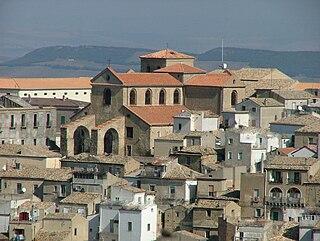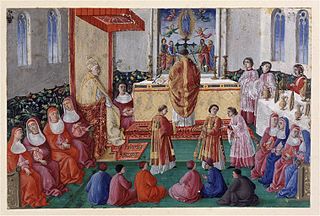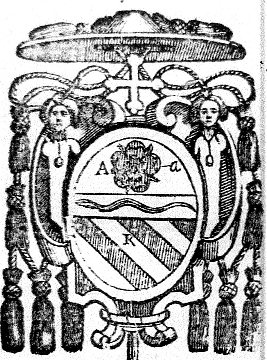Related Research Articles

The House of Orsini is an Italian noble family that was one of the most influential princely families in medieval Italy and Renaissance Rome. Members of the Orsini family include five popes: Stephen II (752–757), Paul I (757–767), Celestine III (1191–1198), Nicholas III (1277–1280), and Benedict XIII (1724–1730). In addition, the family included 34 cardinals, numerous condottieri, and other significant political and religious figures.

Ippolito de' Medici was the only son of Giuliano di Lorenzo de' Medici, born out-of-wedlock to his mistress Pacifica Brandano.

The Archdiocese of Genoa is a Latin Church ecclesiastical territory or diocese of the Catholic Church in Italy. Erected in the 3rd century, it was elevated to an archdiocese on 20 March 1133. The archdiocese of Genoa was, in 1986, united with the Diocese of Bobbio-San Colombano, forming the Archdiocese of Genoa-Bobbio; however a split in 1989 renamed it the "Archdiocese of Genoa."

Giovanni Battista Zeno , was the son of Niccolo di Tomà Zeno and Elisabetta Barbo, a sister of Pietro Barbo, who became Pope Paul II in August 1464. He was a bishop and a cardinal of the Catholic Church.

The Archdiocese of Bologna is a Latin Church ecclesiastical territory or archdiocese of the Catholic Church in Northern Italy. The cathedra is in the cathedral church of San Pietro, Bologna. The current archbishop is Cardinal Matteo Zuppi, who was installed in 2015.
Flavio Orsini was a papal bureaucrat, an Italian bishop, and a cardinal of the Catholic Church. He was son of Ferdinando Orsini, 5th duke of Gravina; and Beatrice Ferrillo, daughter and heiress of Giovanni Alfonso Ferrillo, Conte di Muro Lucano.

The Diocese of Tricarico is a Latin diocese of the Catholic Church in Basilicata. It is a suffragan of the Archdiocese of Potenza-Muro Lucano-Marsico Nuovo.

The Diocese of Rieti is a Latin Church ecclesiastical territory or diocese of the Catholic Church in Italy. It is immediately exempt to the Holy See. Its cathedra is in St. Mary Cathedral in the episcopal see of Rieti.

The Diocese of Padua is a Latin diocese of the Catholic Church in Veneto, northern Italy. It was erected in the 3rd century. The diocese of Padua was originally a suffragan (subordinate) of the Patriarchate of Aquileia. When the Patriarchate was suppressed permanently in 1752, it became a suffragan of the Archdiocese of Udine. In 1818, when the dioceses of northern Italy were reorganized by Pope Pius VII, it became a suffragan of the Patriarchate of Venice, and remains so today.

The Diocese of Volterra is a Latin diocese of the Catholic Church in Tuscany, central Italy. It is a suffragan of the Archdiocese of Pisa.

The Diocese of Tivoli is a Latin Church ecclesiastical territory or diocese of the Catholic Church in Latium, Italy, which has existed since the 2nd century. In 2002 territory was added to it from the Territorial Abbey of Subiaco. The diocese is immediately exempt to the Holy See.

The Archdiocese of Trani-Barletta-Bisceglie is a Latin Church ecclesiastical territory or archdiocese of the Catholic Church in Italy in the province of Barletta-Andria-Trani in Apulia. Formerly a metropolitan see, in 1980 it became a suffragan archdiocese in the ecclesiastical province of the metropolitan Archdiocese of Bari-Bitonto. It received its current name in 1986, when the Archdiocese of Trani added to its title the names of two suppressed dioceses merged into it.

Marco Barbo of Venice was a cousin and lifetime follower of Cardinal Pietro Barbo, who became Pope Paul II in 1464. Marco was appointed Bishop of Vicenza on 17 September 1464; appointed a cardinal of the Roman Catholic Church on 18 September 1467; and Patriarch of Aquileia in 1470. He was a principal papal administrator.

Innocenzo Cibo was an Italian cardinal and archbishop.

Pope Eugene III (1145–1153) created sixteen cardinals in nine consistories:

Pope Sixtus IV created 34 new cardinals in eight consistories:

Giovanni Arcimboldi is called the Cardinal of Novara or the Cardinal of Milan and was an Italian Roman Catholic bishop and cardinal. He served many times as the legate to Perugia and was both a Senator of Milan and ran the archdiocese from 1485-1488.
Giovanni Conti (1414–1493) was an Italian Roman Catholic bishop and cardinal.

Giambattista Orsini was an Italian Roman Catholic cardinal. He served as papal legate to the Marches of Ancona.

Niccolò Brancaccio was born in the Kingdom of Naples, perhaps in Naples itself. He was Archbishop of Bari and then Archbishop of Cosenza, while serving in the Roman Curia in Avignon. He became a cardinal of the Avignon Obedience in 1378, and was Cardinal Priest of Santa Maria in Trastevere and then Cardinal Bishop of Albano. He participated in the Council of Pisa in 1409, and was one of the electors of Pope Alexander V and of Pope John XXIII.
References
- 1 2 3 "Biography from Biographical Dictionary of the Cardinals of the Holy Roman Church". Archived from the original on 2018-01-21. Retrieved 2012-06-16.
- ↑ Giuseppe Cappelletti, Le chiese d'Italia dalla loro origine sino ai nostri giorni Volume 21 (Venezia: Giuseppe Antonelli 1871), p. 54. Cardella, p. 217. G. Carducci and V. Fiorini (edd.), Il diario romano di Jacopo Gherardi da Volterra dal VII settembre MCCCCLXXIX al XII agosto MCCCCLXXXIV (Città di Castello: S. Lapi 1904), p. 80.
- ↑ Chartularium studii bononiensis: Documenti per la storia dell'Università di Bologna dalle origini fino al secolo XV pubblicati per opera dell'Istituto per la storia dell'Università di Bologna, Volumes 1-2 (Bologna: Presso l'Istituto per la storia dell'Università di Bologna, 1907), p. 179.
- ↑ Augustinus Theiner (ed.), Caesaris S.R.E. Cardinalis Baronii Annales Ecclesiastici Tomus 29, 1454-1480 (Bar-le-Duc: 1876), p. 618 § 43.
- ↑ Marino Marini, Serie cronologiche degli abati del monastero di Farfa (Roma 1836), p. 27.
- ↑ Ferdinandus Ughelli, Italia sacra (ed. N. Colet) Tomus VII (Venice: Sebastian Colet, 1721), p. 910.
- ↑ Conradus Eubel, Hierarchia catholica medii aevi II, editio altera (Monasterii 1914), p. 254 and n. 3.
- ↑ Conradus Eubel, Hierarchia catholica medii aevi II, editio altera (Monasterii 1914), p. 19.
- ↑ Eubel, p. 19, note 1: Die denique Sabbati 3 Junii S(ancta) P(ater) in consistorio publico in palatio apost(olico) apud S. Petrum , ut moris est, dedit capellos rubeos.... Salvador Miranda Archived 2018-01-21 at the Wayback Machine wrongly places the event in the Basilica itself.
- ↑ Ludwig Pastor, The History of the Popes, from the Close of the Middle Ages Volume IV (tr. F.I. Antrobus) (London: Kegan Paul 1894), p. 414.
- ↑ G. Carducci and V. Fiorini (edd.), Il diario romano di Jacopo Gherardi da Volterra dal VII settembre MCCCCLXXIX al XII agosto MCCCCLXXXIV (Città di Castello: S. Lapi 1904), pp. 70 and 80.
- ↑ Eubel, p. 254, note 4. Cardella, p. 217. Il diario romano di Jacopo Gherardi da Volterra, p. 80.
- ↑ Eubel, p. 44, no. 448.